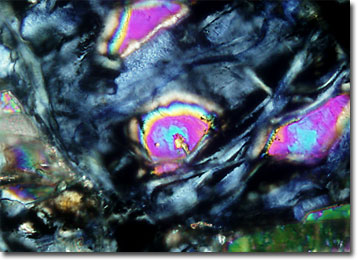Polarized Light Microscopy Digital Image Gallery
Graphitic Marble
Strong and beautiful, marble is usually described as a type of recrystallized limestone or dolomite, but the term is sometimes utilized more freely in commercial circles to refer to any calcium-rich rock that takes an excellent polish. True marbles are often found interbeddded with other metamorphic rocks and occur most heavily in older regions of the Earth’s crust.

The purest marble, which is snow white in color, was a popular building material for the ancient Greeks and Romans, who also commonly utilized the material for artistic purposes. This type of marble is found in several locations, such as the Greek island Paros, Mount Pentelicus located near Athens, and Carrara, Italy. Yet, most marbles contain accessory minerals that produce various colors and patterns in the rock. Among the most common of these minerals are quartz, pyrite, mica, iron oxides, and graphite. Surprisingly various in content and appearance, marbles are generally classified by mineralogical composition or color and pattern.
Graphitic marble is a type of marble that contains appreciable amounts of graphite, a steel-gray to black mineral comprised of carbon. Opaque and very soft, graphite deposits in marble usually appear as gray or silver flakes or swirls when polished, giving a characteristic appearance to the rock. However, when present with other accessory minerals, the overall look of the marble may be quite different, sometimes exhibiting hues of blues, reds, greens, pinks, and yellows as well. The tremendous array of possible marble manifestations contributes greatly to the popularity of the stone for decorative purposes, since types exist that will meet most any specifications.
